|
|
||||
| home | ||||
| Eduction. Design by Algorithm Marialuisa Palumbo |
||||
| DESIGN STRATEGIES AND THEORETIC ISSUES OF MARCOS NOVAK DIGITAL WORLD. |
||||
| [in italiano] | Eduction
is an important work. It is an ephemeral work of high emotional impact, of strong theoretical roots, of expansive potential, and yet may not be easily grasped.
Eduction calls for time. In fact, one thing is to witness the mind's surprising power of action, as in the case that just a few of us have witnessed, of a body becoming completely rigid in response to 'mental stimulation', and quite another is trying to understand the meaning of a journey which moves us from the induction of a trance state of a volunteer to his/her placement at the navigation console of a virtual world that is projected for the audience on a large overhead screen. The attempt of this feat may easily leave us more puzzled than persuaded. However, in order to understand Eduction, it helps to take a step back and think about two main aspects that this project has at stake. First, there is the theoretical side, about the possibility of discovering a kind of rendering or visualization of our mental space. Secondly, there is the technical side that explores the capacity of the digital medium of not just setting in motion a virtual immersion, but also the opposite and inverted vector. This counter-vector moves us from the virtual to the real and renders some 'projections' of portions of space visible that would otherwise usually lie beyond our perception. 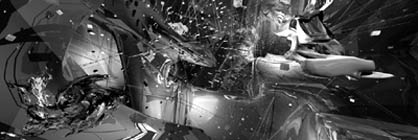 If the theoretical issues center on the debate about the interpretation of the mind, and in particular about its "spatiality", the technical issues concerning the capacities of the digital medium lead us to think about the relationship between architecture, as manipulation of or action on space, and computers. , More specifically about the as yet unusual practice, innovated in this digital era by Marcos Novak: that of designing by algorithm. |
[28dec2001] | ||
| EDUCTION: The Alien Within (by Marcos Lutyens and Marcos Novak). 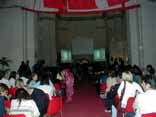  A subject is inducted into a deep state of hypnotic trance. Various tests and deepening procedures are applied that demonstrate the extreme level of hypnotic immersion both to the subject and to the audience. 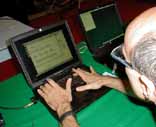 These astonishing tests include a rapid standing induction, levitation of limbs and catalepsy (the body becomes extremely rigid).  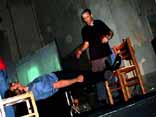 The subject is then introduced in trance into a navigable virtual landscape encased in a flexible structure through which the subject travels. The landscape itself is in flux and reconfigures itself as the journey progresses. The landscape is a configuration of solids and liquids derived from sounds of inductive voices, and upon approaching different areas inductive commands are triggered. The audience is able to follow the immersive journey on a large overhead screen. 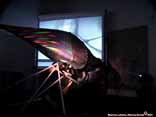  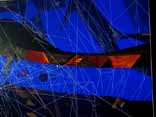 Each time this is performed, both the trajectory and the outcome are different, as these are reconfigured by the intersection of the ever varying eductive-scape with the autonomic nervous system’s responses to the changing environment …as a feedback loop between mental processes and a 3-D suggestive landscape. An eversive process takes place from Psychological to Digital to Analog to Kinesthetic and back around. |
Let's think about it. The architectural world has often considered the digital revolution as a passage from design at the drawing table to computer aided design. But in terms of the possibilities of the manipulation, what is the most profound innovation offered by this new digital tool? The answer should be obvious, but even though it carries such a revolutionary potential, it has been practically ignored by an architectural world focused more on stylistic battles than on a deep questioning about the nature of space. |
|||
 Novak's path is anomalous in this respect and precisely for this reason deeply significant: the transversal nature of his studies, rooted in architecture as well as in music and above all, in computer science, has lead Novak since the end of the 'seventies to think about the nascent relationship between computers and architecture. This investigation not only entailed the use of programs for assisted design, but rather was centered around the programmer as the explorer and 'formalizer' of the logic behind the screen. This is the logic behind the relationship between the line and the digit, between geometric-analogue tools (the line) and mathematical-digital tools (the digit) of space analysis and configuration. So, what is still invisible and incomprehensible to most of the architectural world, for Novak became the spark of a new era of architectural exploration, which no longer takes placed within the confines of a vaguely defined "real" space. 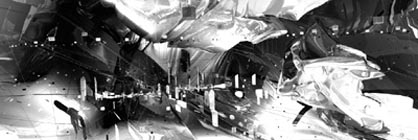 |
||||
| In fact, the most essential change brought about by digital tools, the alliance between the line and the digit, no longer opens the door to the imagination and the articulation of the spatial fact through its analogue representation, by lines, planes and volumes, but through a symbolic code - both logical and mathematical- and so it is able to express the conditions from which emerges what can become a straight line rather than a curved line, a 3-dimensional space rather than a 4-dimensional space and so on. A code in its own right, free from the 3-dimensionality of our every-day perception as well as from the dogma and determinacy of the sign: in fact the algorithm expresses a system of relations, an "order" which binds variable elements to each other. In referring to PADL-2, one of the first non 2-dimensional programs for computer aided design, Novak writes " combining solid modeling, hierarchic structure, and parametric representation, PADL-2 enabled a very powerful conception of form. One could design families of objects by creating general schemata of variable relations, dimensions, and operations. When these variables were given specific values, specific designs were created. Until then, designs remained in a liquid state of potentiality." And what other essential elements have computers brought to architecture other than being able to aid the conception of a variable architecture, an architecture of fluid states, capable of representing not only finished shapes but the very conditions of formalization, in other words the manipulation in mathematical terms, of the structure of space?  |
||||
| Going back to
Eduction, at this stage it is necessary to complete another link in the chain, concerning the interpretation of the Digital and the revolution it has provoked. In fact, even though the architectural world is only one of several spheres in which the digital has been regarded as the generator of a one-way vector from the real to the virtual,
Eduction on the contrary invites us to consider the possibility of inverting the vector, opposing the digital and virtual impetus towards immersion, by the counter process of e-mersion or eversion of the virtual into the real. In architectural terms, the issue is that of establishing whether beyond the paradigm of a Virtual Reality that has no intersection with the real world other than through an interface, a kind of presence or echo of the virtual into the real has become possible. According to Novak, this issue is strongly connected to the issue of visibility, or actually invisibility of most of reality to our senses. We are only capable of perceiving the smallest fraction of the electromagnetic spectrum (1/(3x1035)) as well as of existing spatial dimensions. But if according to this perspective, to talk about "invisible architecture" assumes a fairly concrete meaning –denoting with this name the architecture nested within the portion of space beyond the limits of visibility of our retina and in general of our systems of perception but nevertheless not differently manipulable through algorithmic design procedures- it is also possible to imagine, for example "visible" architecture as an effect or 3-dimensional projection of multi-dimensional formal systems. The implication is that some kind of "eversion" of the virtual into the real is finally possible through recourse to a dimensional filter (by selecting, for example, three dimensions at once of a four dimensional object, obtaining four different projections of a 4-dimensional object). |
||||
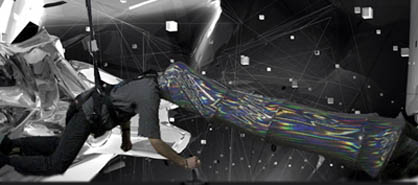 By bringing together fluidity and multi-dimensionality, we have obtained the two main features of the design environment in which the virtual world of Eduction is grounded. However, a third element is actually at the heart of this "dream machine" which aspires to render visible the hidden patterns of the mind. This is a very special algorithm which builds a bridge between subject and object, between eye and shape, observer and observed. In fact, Eduction does not simply show a world of shapes that progressively emerge from a previous state of potentiality. Eduction develops a virtual environment that progressively evolves from a state of latent potentiality to a complex evolutionary stage through the interaction between formal "variables" and the navigation process, through a law of interactivity between subject and object. If you have seen Eduction, you'll probably remember the gradual transformation within a differentiated and articulated landscape of the dark nebula in which the first virtual steps were undertaken by the volunteer psychonaut. The virtual space is progressively built up or "takes shape" in response to the specific navigation of the psychonaut and his/her reaction, or interaction with the basic elements of the landscape in what Novak and Lutyens call a "feedback loop" from psychological to digital to analogue to kinesthetic and back around. Although the interaction mechanism at the moment is limited to the choice of navigation path (through a joystick), as the project evolves, the elaboration of a complex system of conscious and unconscious responses will be measured and incorporated through biomedical scanning devices able to detect psychophysical and cerebral responses. These devices will be woven into the more conventional VR interface. And so Eduction: the alien within, as a hybrid architecture of real and virtual, as performance, as installation and concert, opens the horizon of virtual worlds capable of interacting at the deepest levels of mental activity of the surfing subject. Once again, Eduction calls for time, because the process which it has begun will certainly not end today, nor tomorrow, but rather calls for a patient process of coding and decoding. This is an exciting but extremely complex task. The aim is to elaborate, in scientific and technical terms, a process of interaction and circularity between space and mind, or between the psychophysical activity of a subject within a space and the metamorphosis of this space, in real time. In other words, the ultimate aim is to mirror a space different from all others: the individual's space of mind. Marialuisa Palumbo malupa@libero.it |
||||
|
>
MARCOS NOVAK |
||||
| laboratorio
|
||||